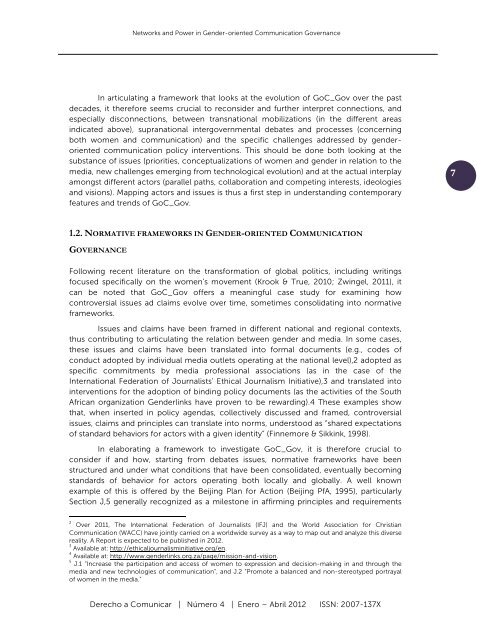21aiiMmFK
21aiiMmFK
21aiiMmFK
Create successful ePaper yourself
Turn your PDF publications into a flip-book with our unique Google optimized e-Paper software.
Networks and Power in Gender-oriented Communication Governance<br />
In articulating a framework that looks at the evolution of GoC_Gov over the past<br />
decades, it therefore seems crucial to reconsider and further interpret connections, and<br />
especially disconnections, between transnational mobilizations (in the different areas<br />
indicated above), supranational intergovernmental debates and processes (concerning<br />
both women and communication) and the specific challenges addressed by genderoriented<br />
communication policy interventions. This should be done both looking at the<br />
substance of issues (priorities, conceptualizations of women and gender in relation to the<br />
media, new challenges emerging from technological evolution) and at the actual interplay<br />
amongst different actors (parallel paths, collaboration and competing interests, ideologies<br />
and visions). Mapping actors and issues is thus a first step in understanding contemporary<br />
features and trends of GoC_Gov.<br />
7 <br />
1.2. NORMATIVE FRAMEWORKS IN GENDER-ORIENTED COMMUNICATION<br />
GOVERNANCE<br />
Following recent literature on the transformation of global politics, including writings<br />
focused specifically on the women’s movement (Krook & True, 2010; Zwingel, 2011), it<br />
can be noted that GoC_Gov offers a meaningful case study for examining how<br />
controversial issues ad claims evolve over time, sometimes consolidating into normative<br />
frameworks.<br />
Issues and claims have been framed in different national and regional contexts,<br />
thus contributing to articulating the relation between gender and media. In some cases,<br />
these issues and claims have been translated into formal documents (e.g., codes of<br />
conduct adopted by individual media outlets operating at the national level),2 adopted as<br />
specific commitments by media professional associations (as in the case of the<br />
International Federation of Journalists’ Ethical Journalism Initiative),3 and translated into<br />
interventions for the adoption of binding policy documents (as the activities of the South<br />
African organization Genderlinks have proven to be rewarding).4 These examples show<br />
that, when inserted in policy agendas, collectively discussed and framed, controversial<br />
issues, claims and principles can translate into norms, understood as “shared expectations<br />
of standard behaviors for actors with a given identity” (Finnemore & Sikkink, 1998).<br />
In elaborating a framework to investigate GoC_Gov, it is therefore crucial to<br />
consider if and how, starting from debates issues, normative frameworks have been<br />
structured and under what conditions that have been consolidated, eventually becoming<br />
standards of behavior for actors operating both locally and globally. A well known<br />
example of this is offered by the Beijing Plan for Action (Beijing PfA, 1995), particularly<br />
Section J,5 generally recognized as a milestone in affirming principles and requirements<br />
2<br />
Over 2011, The International Federation of Journalists (IFJ) and the World Association for Christian<br />
Communication (WACC) have jointly carried on a worldwide survey as a way to map out and analyze this diverse<br />
reality. A Report is expected to be published in 2012.<br />
3<br />
Available at: http://ethicaljournalisminitiative.org/en.<br />
4<br />
Available at: http://www.genderlinks.org.za/page/mission-and-vision.<br />
5<br />
J.1 “Increase the participation and access of women to expression and decision-making in and through the<br />
media and new technologies of communication”, and J.2 “Promote a balanced and non-stereotyped portrayal<br />
of women in the media.”<br />
Derecho a Comunicar | Número 4 | Enero – Abril 2012 ISSN: 2007-137X



